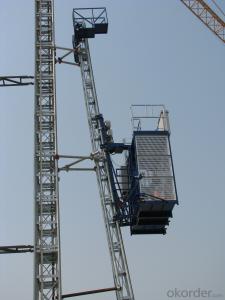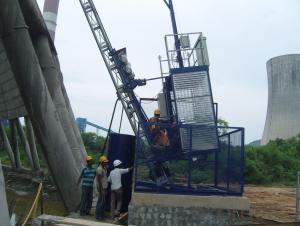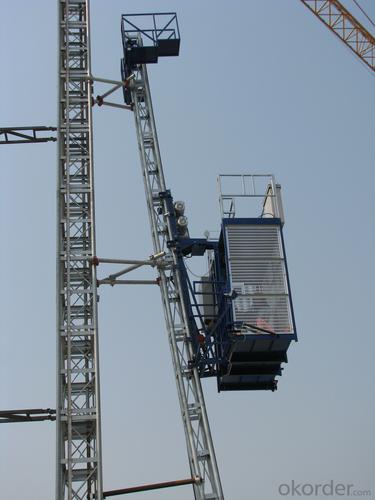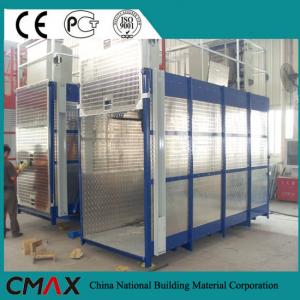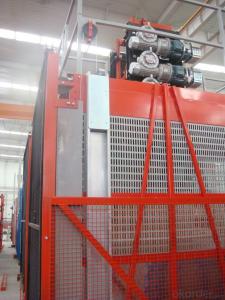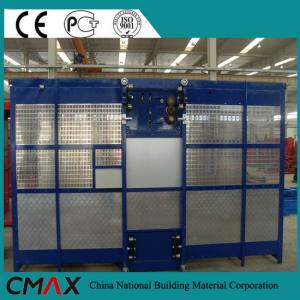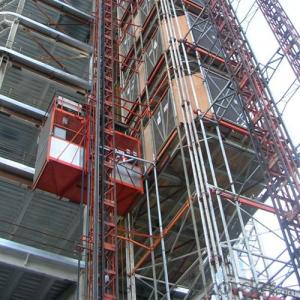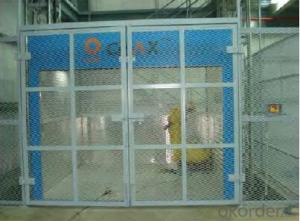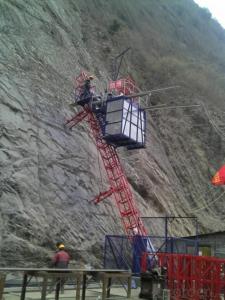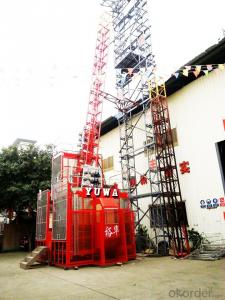SCQ60 Curved Hoist
- Loading Port:
- Tianjin
- Payment Terms:
- TT or LC
- Min Order Qty:
- -
- Supply Capability:
- 30 units unit/month
OKorder Service Pledge
OKorder Financial Service
You Might Also Like
Building Hoist SCQ60
Condition: New
Application: Construction
Payload(kg):600
Lifting Speed(m/min):0~33
Motor Power(kw): 2*3*22
Safety Device: 2*SAJ50-1.4
Cage: Single cage
Counterweight: No
Certification: CE/ ISO
Place of Origin: China(Mainland)
Model Number: Type:SCQ60
Packaging & Delivery of Building Hoist
Packaging Detail: Nude package Delivery Detail: 15-20days
Main Parts of Building Hoist
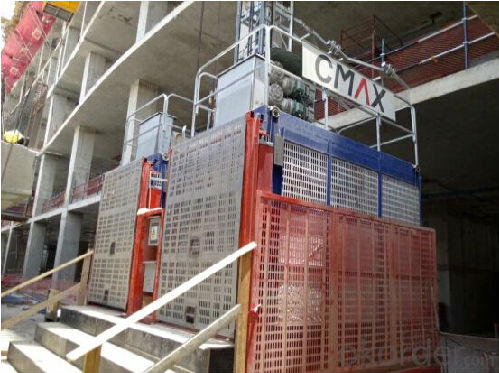
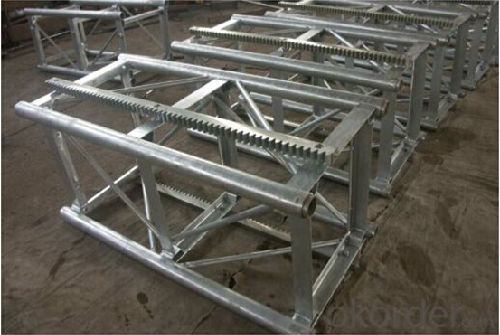
Feature:
● Adopts the most advanced VF speed control device and microcomputer programmable logic controller.
● Stepless speed control helps eliminate the concussion during start up and braking, steady the operation process,
and ensures automated leveling.
● Adopts open loop V/Fcontrol; the speed control precision can reach ±2~3%. Realizes accurate low speed positioning of the hoist and avoid slipping during downward stopping of hoist.
● The VF system has current-restriction function, ensuring a small current when motor start up and reducing the concussion to power supply. It reduces the engery consumption and mitigates effects to on site electric equipments.
● The steadiness during running mitigates concussion to mechanical parts, reduces wears of rack, pinion and the brake
and prolongs the spare parts'life.
● The VF system also has the over voltage protection,low voltage protection, overcurrent, overload and anti-stalling protection functions,
● The system applies the special software for hoists developed by our company, making the operation more safe and
reliable.
Building Hoist Specifiction
FAQ of Building Hoist
Q: What is the building hoist main purpose?
A: Building hoist equipped with single cabin to transport the materials and labors up and down. It's the ideal
construction equipment in the field of construction.
Q: What is the main structure of building hoist?
A: construction hoist mainly contains metal structure, driving system, electrical control system, cable guide &
protection system
Q: What is the meaning of the building hoist’s code?
A: “SC” stands for rack and pinion hoist, “200/200” stands for double cage and capacity is 2 tons per cage.
Q: What is the dimension of the cage?
A: Normally the cage dimension is 3X1.5X2.5M (L/W/H) for 2t type hoist. There are two doors (entrance
& exit doors) for each cage, It can be produced as up & down sliding or ramping model for safety and convenience.
- Q: Is it possible to utilize a building hoist for the purpose of lifting small tools and equipment?
- <p>Yes, a building hoist can be used for lifting small tools and equipment, provided it is within the hoist's weight capacity. It's important to ensure that the items are securely fastened to prevent any accidents during lifting. Always follow the manufacturer's guidelines and safety regulations when using a building hoist for any lifting tasks.</p>
- Q: The construction elevator can not operate during the use of several stages of wind power
- 11, when the wind speed exceeds 20m/s and the bad weather, such as hail, not use the lift." I'm a construction elevator This is the norm It's about a six-stage wind by 20m/s.
- Q: This question asks about the process of changing the speed of a building hoist, which is a device used in construction to lift materials.
- <p>Adjusting the speed of a building hoist typically involves accessing the hoist's control panel or motor settings. For electric hoists, this may include adjusting the frequency of the power supply through a variable frequency drive (VFD), which alters the speed of the motor. For manual hoists, speed adjustments might involve changing the gear ratio or the tension on the hoisting rope. Always refer to the hoist's user manual for specific instructions, as different models have different mechanisms. Safety should be a priority; ensure that any adjustments are made by trained personnel and in compliance with safety regulations.</p>
- Q: This question asks for an explanation on how to operate a winch, specifically in the context of a building hoist.
- <p>To use a winch, particularly a building hoist, follow these steps: Ensure the winch is securely anchored and the cable is in good condition. Attach the load to the hook, ensuring it's balanced. Turn the winch handle clockwise to lift the load; counterclockwise to lower it. Always keep tension on the cable to prevent it from slacking. Use a tag line to guide the load horizontally. Never exceed the winch's load limit. Regularly inspect the winch and cable for wear and tear. Always have a spotter to assist and communicate during the operation. Safety is paramount, so never leave the winch unattended while the load is in the air.</p>
- Q: This question asks for the steps or methods to fix a building hoist that is not working properly.
- <p>To repair a malfunctioning building hoist, first, ensure the hoist is powered off and disconnected from any power source to ensure safety. Inspect the hoist for visible damage or loose parts. Check the motor, cables, and control panel for any signs of wear or damage. If the issue is mechanical, such as a stuck cable or a jammed pulley, disassemble the affected parts and clean or replace them as necessary. For electrical issues, inspect the wiring and connections for any shorts or breaks. Consult the hoist's manual for troubleshooting guides specific to the model. If the problem persists or if you're unsure about any steps, it's best to contact a professional technician for repair to avoid further damage or safety hazards.</p>
- Q: What is the highest weight a building hoist can safely lift?
- <p>The maximum load capacity of a building hoist can vary significantly depending on the specific model and design. Generally, capacities range from 500 kg to 3,000 kg or more. It's crucial to refer to the manufacturer's specifications for the exact load capacity of any given hoist. Overloading a hoist can lead to accidents and damage, so it's essential to operate within the specified limits.</p>
- Q: Is it possible to use a building hoist, typically meant for construction purposes, to lift a bicycle?
- <p>While technically possible, using a building hoist to lift a bicycle is not recommended due to safety concerns. Building hoists are designed for heavy construction materials and may not be suitable for delicate items like bicycles. The risk of damage to the bicycle or injury to the operator is high. It's best to use a bicycle lift or a hand truck designed for such purposes to ensure the safety of both the bicycle and the person handling it.</p>
- Q: This question asks about the time required to install a building hoist, a device used for lifting materials in construction.
- <p>The time it takes to install a building hoist can vary significantly based on factors such as the type and size of the hoist, the specific building requirements, and the experience of the installation team. On average, it can take anywhere from a few hours to a couple of days. For smaller hoists, installation might be completed within a day, while larger, more complex systems could take longer. It's important to note that safety checks and regulatory compliance verifications are also part of the process, which can add to the total installation time.</p>
- Q: Is it possible for a hydraulic cylinder in a building hoist to be serviced or replaced by individuals other than the manufacturer?
- <p>Yes, a hydraulic cylinder in a building hoist can be repaired or replaced by qualified individuals or companies other than the manufacturer. However, it is crucial to ensure that the service provider has the necessary expertise and follows the manufacturer's specifications to maintain safety and performance standards. Using non-genuine parts or improper installation can lead to safety hazards and void warranties. It is always recommended to consult with professionals who are familiar with the specific hoist model and have experience in hydraulic systems repair and maintenance.</p>
- Q: Is it possible to utilize a hydraulic cylinder in the construction of a building hoist?
- <p>Yes, hydraulic cylinders can be used in building hoists. They are often employed in lifting systems due to their ability to generate large forces in a controlled manner. Hydraulic cylinders provide smooth and precise control over heavy loads, which is crucial for the safe and efficient operation of a building hoist. They can handle the vertical movement of materials and personnel in construction settings, ensuring a stable and reliable lifting mechanism.</p>
Send your message to us
SCQ60 Curved Hoist
- Loading Port:
- Tianjin
- Payment Terms:
- TT or LC
- Min Order Qty:
- -
- Supply Capability:
- 30 units unit/month
OKorder Service Pledge
OKorder Financial Service
Similar products
Hot products
Hot Searches
Related keywords
